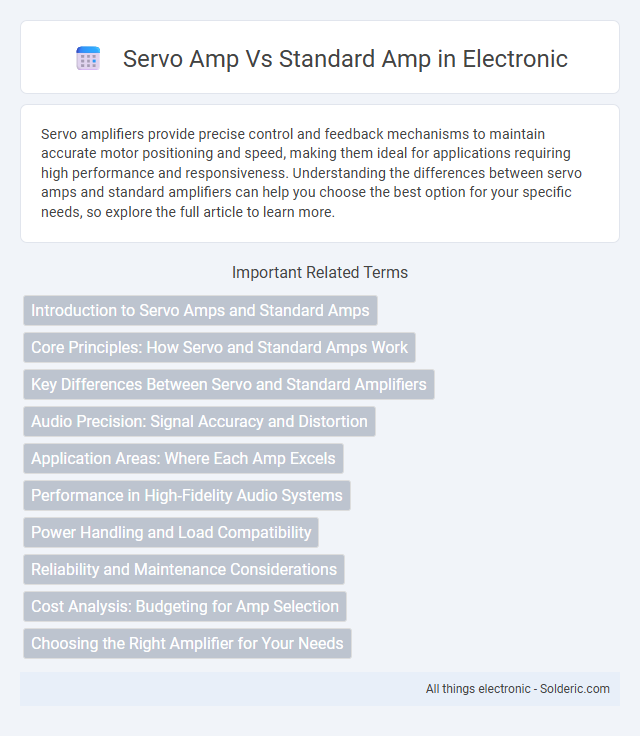Servo amplifiers provide precise control and feedback mechanisms to maintain accurate motor positioning and speed, making them ideal for applications requiring high performance and responsiveness. Understanding the differences between servo amps and standard amplifiers can help you choose the best option for your specific needs, so explore the full article to learn more.
Comparison Table
| Feature | Servo Amplifier | Standard Amplifier |
|---|---|---|
| Control Type | Closed-loop feedback control | Open-loop or minimal feedback |
| Accuracy | High precision with error correction | Moderate accuracy, prone to drift |
| Applications | Robotics, CNC machines, precise positioning | Basic audio, power amplification |
| Response Time | Fast, real-time adjustments | Slower, fixed gain |
| Cost | Higher due to complexity and components | Lower, simpler design |
| Complexity | Advanced circuitry with sensors | Simple circuitry |
| Power Efficiency | Typically optimized for efficiency | Varies, generally less efficient |
Introduction to Servo Amps and Standard Amps
Servo amplifiers utilize feedback loops to precisely control motor position, speed, and torque, enhancing accuracy and responsiveness in industrial applications. Standard amplifiers provide basic power amplification without feedback mechanisms, resulting in simpler control suited for less demanding motor functions. Servo amps are preferred in robotics and CNC machines, while standard amps are commonly used in conventional motor drives.
Core Principles: How Servo and Standard Amps Work
Servo amplifiers use feedback loops to continuously monitor and adjust the output, maintaining precise control over motor position or speed by comparing actual performance to the desired input. Standard amplifiers provide fixed power amplification without real-time correction, delivering a consistent output based on the input signal but lacking dynamic adjustment for load variations or errors. Servo amps integrate sensors and control systems to ensure accuracy and stability, while standard amps prioritize basic signal amplification for simpler applications.
Key Differences Between Servo and Standard Amplifiers
Servo amplifiers feature feedback systems that monitor and adjust output signals to minimize distortion and improve sound accuracy, while standard amplifiers operate without this continuous correction mechanism. Servo amps typically offer better bass response and lower total harmonic distortion (THD), enhancing overall audio fidelity. Standard amplifiers are often simpler, more cost-effective, and suitable for general applications where absolute precision is less critical.
Audio Precision: Signal Accuracy and Distortion
Servo amplifiers employ feedback mechanisms to enhance signal accuracy, significantly reducing harmonic distortion compared to standard amplifiers. Audio Precision measurements reveal servo amps deliver cleaner output with lower Total Harmonic Distortion (THD) and improved linearity across frequency ranges. Standard amplifiers often exhibit higher noise levels and signal deviation, resulting in less precise audio reproduction and increased distortion artifacts.
Application Areas: Where Each Amp Excels
Servo amplifiers excel in applications requiring precise motor control and high torque at low speeds, such as robotics, CNC machinery, and automation systems. Standard amplifiers are better suited for general-purpose tasks like powering household electronics, audio systems, and basic motor drives where simplicity and cost-effectiveness are priorities. Your choice depends on the specific performance needs and complexity of the application environment.
Performance in High-Fidelity Audio Systems
Servo amplifiers provide superior performance in high-fidelity audio systems by precisely controlling speaker cone movement, reducing distortion and improving sound clarity. Standard amplifiers may exhibit higher distortion levels and less accurate transient response, affecting audio detail and dynamic range. Your high-fidelity system benefits from a servo amp's enhanced accuracy, delivering cleaner bass and more faithful sound reproduction.
Power Handling and Load Compatibility
Servo amplifiers provide superior power handling by actively monitoring and adjusting output to prevent distortion, enabling efficient delivery of clean power under varying loads. Standard amplifiers have fixed power ratings and may struggle with non-linear loads, leading to higher distortion and potential damage. Your audio system benefits from a servo amp's ability to maintain consistent performance and compatibility across diverse speaker impedances and load conditions.
Reliability and Maintenance Considerations
Servo amplifiers offer enhanced reliability due to their closed-loop feedback systems that continuously monitor and adjust motor performance, reducing wear and extending component lifespan compared to standard amplifiers. Standard amps, reliant on open-loop control, may require more frequent maintenance because of susceptibility to drift and inefficient torque handling. Your choice of amplifier influences long-term maintenance schedules and operational uptime, with servo amps generally providing lower service requirements and improved system stability.
Cost Analysis: Budgeting for Amp Selection
Servo amps typically cost more initially due to their advanced feedback mechanisms offering greater precision and efficiency, while standard amps are generally more affordable and simpler to maintain. Your budgeting should consider long-term operational savings from energy efficiency and reduced distortion in servo amps against the lower upfront investment of standard amps. Factoring in maintenance, energy consumption, and performance needs ensures a cost-effective amp selection aligned with your financial goals.
Choosing the Right Amplifier for Your Needs
Servo amps provide precise low-frequency control and reduced distortion, making them ideal for subwoofers and applications requiring accurate bass reproduction. Standard amplifiers deliver broader frequency response with simplicity and lower cost, suited for general audio setups and mid-to-high range speakers. Selecting the right amplifier depends on your system's requirements for audio fidelity, speaker type, and budget constraints.
Servo amp vs Standard amp Infographic

 solderic.com
solderic.com